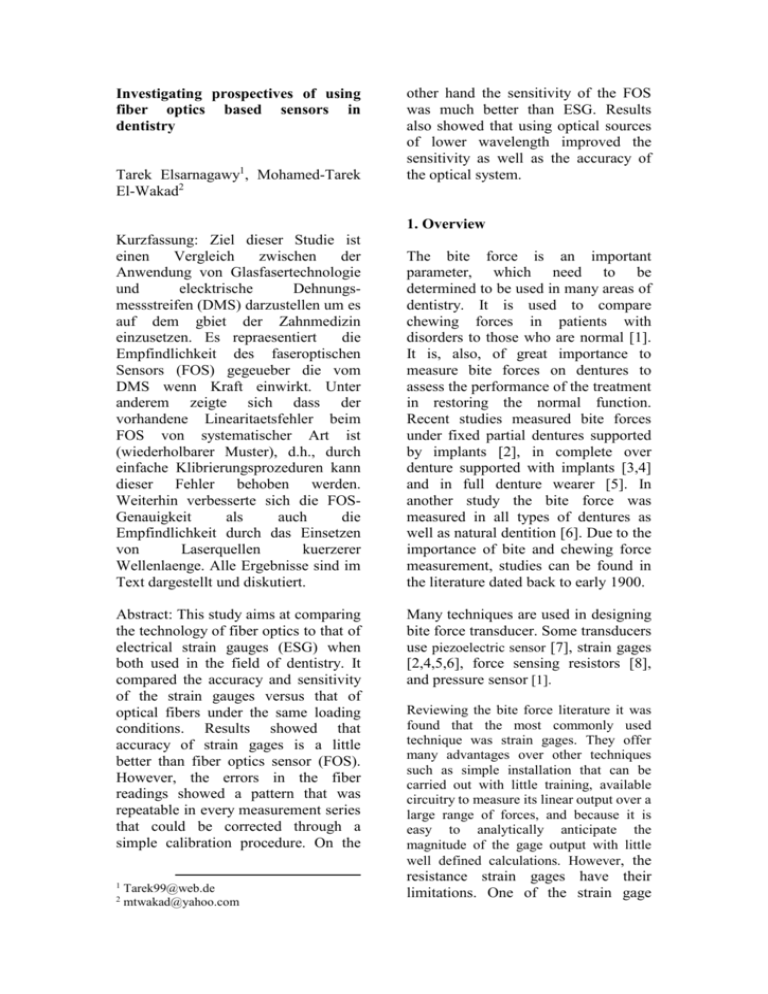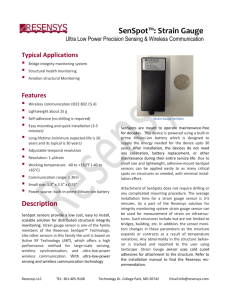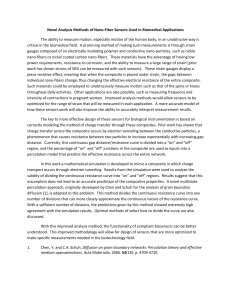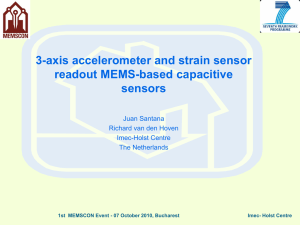Chewing & Bite forces measurement based on fiber optics
advertisement

Investigating prospectives of using fiber optics based sensors in dentistry Tarek Elsarnagawy1, Mohamed-Tarek El-Wakad2 other hand the sensitivity of the FOS was much better than ESG. Results also showed that using optical sources of lower wavelength improved the sensitivity as well as the accuracy of the optical system. 1. Overview Kurzfassung: Ziel dieser Studie ist einen Vergleich zwischen der Anwendung von Glasfasertechnologie und elecktrische Dehnungsmessstreifen (DMS) darzustellen um es auf dem gbiet der Zahnmedizin einzusetzen. Es repraesentiert die Empfindlichkeit des faseroptischen Sensors (FOS) gegeueber die vom DMS wenn Kraft einwirkt. Unter anderem zeigte sich dass der vorhandene Linearitaetsfehler beim FOS von systematischer Art ist (wiederholbarer Muster), d.h., durch einfache Klibrierungsprozeduren kann dieser Fehler behoben werden. Weiterhin verbesserte sich die FOSGenauigkeit als auch die Empfindlichkeit durch das Einsetzen von Laserquellen kuerzerer Wellenlaenge. Alle Ergebnisse sind im Text dargestellt und diskutiert. Abstract: This study aims at comparing the technology of fiber optics to that of electrical strain gauges (ESG) when both used in the field of dentistry. It compared the accuracy and sensitivity of the strain gauges versus that of optical fibers under the same loading conditions. Results showed that accuracy of strain gages is a little better than fiber optics sensor (FOS). However, the errors in the fiber readings showed a pattern that was repeatable in every measurement series that could be corrected through a simple calibration procedure. On the 1 Tarek99@web.de 2 mtwakad@yahoo.com The bite force is an important parameter, which need to be determined to be used in many areas of dentistry. It is used to compare chewing forces in patients with disorders to those who are normal [1]. It is, also, of great importance to measure bite forces on dentures to assess the performance of the treatment in restoring the normal function. Recent studies measured bite forces under fixed partial dentures supported by implants [2], in complete over denture supported with implants [3,4] and in full denture wearer [5]. In another study the bite force was measured in all types of dentures as well as natural dentition [6]. Due to the importance of bite and chewing force measurement, studies can be found in the literature dated back to early 1900. Many techniques are used in designing bite force transducer. Some transducers use piezoelectric sensor [7], strain gages [2,4,5,6], force sensing resistors [8], and pressure sensor [1]. Reviewing the bite force literature it was found that the most commonly used technique was strain gages. They offer many advantages over other techniques such as simple installation that can be carried out with little training, available circuitry to measure its linear output over a large range of forces, and because it is easy to analytically anticipate the magnitude of the gage output with little well defined calculations. However, the resistance strain gages have their limitations. One of the strain gage limitations is the limited sensitivity of strain gages appearing in their low gage factor magnitude (about 2). Another and the most important limitation is the relatively large size of the gauge as applies to bite force transducers. The large size of the gauges requires the height of the bite force transducer to be in the range of about 10 millimeters which causes a bite opening. Such bite opening has been proved to reduce the magnitude of the bite force a patient can exert. Consequently, it does not give a real measure of such force. Thus, new advances in the area of bite force transducers and measurements should offer a miniature transducer of height less than 5mm. It would, also, be advantageous if the accuracy and sensitivity of the new transducer can be improved compared to those using the strain gage. Since it would be used in the oral cavity, it would be advantageous if no electrical connections are involved in the cavity for safety measures. Fiber optics provide advantages over their electrical counterparts, namely, immunity to electromagnetic interference, lightweight, small size, high sensitivity, large bandwidth, and ease in implementing multiplexed or distributed sensors. Strain, temperature and pressure are the most widely studied measurands and the fiber grating sensor represents the most widely studied technology for optical fiber sensors. Today, some success has been found in the commercialization of optical fiber sensors. However, in various fields they still suffer from competition with other mature sensor technologies. However, new ideas are being continuously developed and tested not only for the traditional measurands but also for new applications such as the development of fiber optics in the field of nanosensors, nano-biosensors, PH sensors, humidity sensors, and fluorescent biosensors. In addition, optical fiber sensors possess extreme sensitivity as well as electrical passivity. The later advantage is important for the safety in some applications such as in medical sensors [9]. Developed fiber optic sensors along with some light processing techniques have been known to be the most sensitive technologies to measure displacements as small as 10–10 mm. Hence, the idea to use optical fibers for means of sensing is not a new one. Several publications have shown its variety of application. A load cell for loads up 10000 N with a resolution in the range of 10-6 and stability was presented. Furthermore, Zhao presented an electromagnetic force sensor based on fiber Bragg grating [10]. The bend loss in optic fibers was used in the measurement of distributed force over a surface [11]. Referring to the listed applications and advantages, this article will demonstrate a comparison study between electrical strain gauges and optic fiber strain gauges for high accuracy measurement of strain. The results will be used as a base for future works in the field of single- & multipoint force measurement. 2. Material and Method This is a preliminary study to develop an optical technique to be used to measure forces in dentistry. Optical interferometry is one of the most sensitive technologies to measure small displacements which can later be related to forces. Displacements in the range of nanometers can be resolved by applying interferometric techniques. The common fiber interferometric sensor configurations that are usually applied in fiber optical sensors are Michelson, Mach-Zehnder and Sagnac interferometers. In this work the Michelson fiber optical sensor configuration is used to sense strain. This interferometric principle was chosen because it is optimum with the use of the 3x3-fibercoupler. In accordance a digital readout is simply obtained with a photo detector and a phase-based-updown counter. Hence, a lot of digitization electronics are saved. Therefore, this technique was used in the optical system of the experimental setup as described later in this section. To validate the optical system results strain gauges were used since it is the most common sensors applied in dentistry transducers. 2.1. Experimental setup The experimental setup consists of 4 components as follows: 1. Specimen: A cylindrical specimen was used to resemble a dental implant. On this specimen both the stain gauge and fiber optic were mounted using proper adhesive (EPOTEK 353ND). 2. Optical system: This system has 3 subcomponents as described below: Optical Sources: Two different sources were used. The first source used was a pigtail single-mode diode Laser (Seastar, Diode Mitsubishi ML5415, = 826,3 nm). To ensure a constant output wavelength, the Laser diode module is electronically temperature and current controlled which is important for the interferometric configuration. The second source used was a HeNe-Laser with a shorter wavelength (632nm). The purpose of this source was to study the effect of shorter wavelength on the accuracy of the output Single-mode fiber (SM800FIBERCORE LTD) of an outer diameter of 125μm, 240μm coating outer diameter, numerical aperture of 0.11 and a launch spot size of 6μm is used to act as the sensor and reference of the interferometer. The fiber coupler: the function of this coupler is to condition the light paths within the sensor and the reference fiber. In addition, it transfers the light from the laser source into the fiber and back to be processed. This type of coupler provides a constant phase shift between the signals in the coupler arms which is 120 degree. This leads to the operation at semi quadrature for means of detection of the induced phase variation due to the measurand. 3. Strain gauge system: Strain gauge (Electrical strain gauges ESG:Typ 3/120XY11, HBM, = 11 ppm/K) was monted on the same specimen on which the fiber is mounted. The strain gauge was connected to stain meter (Vishay, System 6000, model 6200 scanner, NC, USA). 4. Temperature Sensor: A temperature sensor (AD590) was used in the setup. The purpose of the sensor was to monitor the end of the transient heating stage of the strain gauge related to the initiation of current flow into the gauge. At the end of such stage measurements can start without errors due to the heating effect. Figure 1 below is a block diagram showing the previously mentioned components as it appears in the experimental setup and Figure 1: Basic schematic diagram of experimental setup 2.2. Calibration procedure The ESG and FOS were mounted on the same specimen, so that both sensors experience the same strain. A static load was applied on the specimen at an increment of 10 kN starting from zero load up to 100 kN. The output data from the FOS and the ESG are of different units. Since the main function of these gauges are supposed to measure strain, therefore it is more reasonable to change data from each sensor into strain for comparison purposes. The output of the FOS was converted into strain using the following Phase-Strain-Sensitivity equation G 4 1 n 1 n²(1 ) p12 p11 L 2 …(1) This equation takes into consideration mechanical, optical and geometrical properties of the fiber. By substituting the used values of the FOS in above equation it leads to G (for single mode standard fiber) = 1.89107 radm-1. Similarly, the output of the ESG was converted to strain, using equation relating Wheatstone bridge output to strain and take into consideration the strain gage factor as in the following equation (2): GaugeFactor R R …….(2) 3. Result and Discussion Figure2 shows the results of the calibration process involving ESG and both FOS with laser diode and with helium. As shown in the figure, the calibration curves are both linear within the range of the force. This gives the advantage of being able to predict the applied force using simple calibration equations obtained through linear curve fitting. Figure 2: The output strain from all strain during calibration process The figure, also, shows that the accuracy of both FOS curves as indicated by the slope of their lines is less than that of ESG. However, among the FOS sensors the heliumbased sensor is more accurate than the laser diode-based sensor. It can be clearly seen that the results of the helium-based sensor is very close to that of (ESG). Thus, the shorter the wavelength used in the optical sensor the closer the result is going to be to the strain gauge results. Consequently, using an even shorter wavelength than the helium (e.g. Excimer lasers with in the range of 150 to 350 nm) is expected to give results even closer to those of the strain gauge. To explore the accuracy of all used sensors in more details the results of all sensors were plotted against the theoretical strain that should have been measured (Fig 3). The theoretical strain was calculated using axial strain equation which takes into consideration the geometrical properties of the structure on which the sensors are mounted as well as the mechanical properties of the structure material. Figure 3 shows that the results of ESG besides being linear, it has a slope of about 43 degrees (ideal: 45deg.). This means that the relationship between strain measured by ESG and the theoretical one is almost one-to-one relationship. The deviation is about 7.5% from the theoretical reading. This is acceptable considering the factors that may cause systematic errors and may lower the accuracy that occurs during the mounting process of the gauge such as the gage alignment and the thickness of adhesive layer. Also, in figure 3 the slope of the fitted line into the results of laser diodebased FOS is about 38 degrees. It shows a deviation of 22 % from the expected theoretical value. This is a larger deviation compared to that of ESG. This larger deviation is on one hand due to the adhesive that acts with lateral forces on the embedded fiber which causes an increase of the photoelastic effect (sandwich effect). Since the photoelastic effect opposes the longitudinal measuring effect, this causes a reduction of sensitivity as well as accuracy. This comes in addition to the much thicker glue layer used to sandwich the optical fibers, as well as the slippage that may occur between the fiber and its sheath. On the other hand, the slope of the fitted line into the results of heliumbased FOS is about 41.5 degrees. It shows a deviation of 11.5 % from the expected theoretical value. This deviation is almost half of the laser diode deviation and is a little higher than that of ESG. The deviation can be explained due to the same factors mentioned in the laser diode section. However, it is not as high as the laser diode due to the shorter wavelength of helium (632nm) compared to laser diode wave length (835 nm). Figure 3: Comparing the strain output of all sensors to theoretical strain Generally, the accuracy of the fiber sensor is lower than that of the electrical gauge. However, the error is merely systematic. Thus, the value of the error can be either deduced and algebraically added to the measured value or incurred into the equation of the calibration line in order to compensate for this error. On the other hand, such error limitation is counter acted by the advantages of safely using it in the oral cavity since it requires no electrical connections. In terms of sensitivity, it can be easily shown that it is higher in the case of FOS compared to ESG. Since the measurement in the FOS is counts, thus, the smallest detectable signal is one count. According to equation (1) the smallest detectable strain value by FOS can be determined to be 0.017 µstrain. On the other hand, a sensitive commercial strain meter can detect down to one µ-strain. This shows how high the sensitivity of the FOS compared to the ESG. Hence, the FOS can be applied to measure very small as well as high acting forces at the same time which need to be measured in dental occlusal analysis systems to reduce risks of implant failure, traumatized teeth, unstable dentures, ineffective splints and porcelain features or anywhere occlusion plays a role. 4. Conclusions The purpose of this study was to compare fiber optic sensor against electrical strain gauge sensor when used in dentistry and/or other biological environment. Within the limits of this study the following can be concluded: 1. Optical sensors provide a safer and a more sensitive application in the biological environment as compared to electrical sensors. 2. The accuracy of optical fiber sensor is a little less than that of the stain gauge. 3. The inaccuracy is repeatable and can be corrected by calibration means. 4. The accuracy and sensitivity and hence resolution of the fiber optic sensor can be improved by using optical light sources of shorter wavelengths. 5. In future articles, results of applying FOS without adhesive will be discussed as a way to improve its functionality. 6. References [1] LR Bonjardim, MB Gaviao, LJ Pereira, PM Castelo, "Bite force determination in adolescents with and without temporomandibular dysfunction", J Oral Rehabil. 2005 Aug; 32(8):577-83. [2] MC Cehreli, K Akca, "Narrowdiameter implants as terminal support for occlusal three-unit FPDs: a biomechanical analysis", Int J Periodontics Restorative Dent. 2004 Dec;24(6):513 – 519. [3] R Mericske-Stern, GA Zarb, "In vivo measurements of some functional aspects with mandibular fixed prostheses supported by implants" Clin Oral Implants Res. 1996A Jun;7(2):153 – 161. [4] FM van Kampen, A van der Bilt, MS Cune, F Bosman, "The influence of various attachment types in mandibular implantretained overdentures on maximum bite force and EMG", J Dent Res. 2002 Mar;81(3):170-173. [5] MT El-Wakd, JB Brunski, "Development of a multidirectional transducer to measure loading on dental implants", 3rd Inter Conf. Faculty of Engineering, Cairo, Egypt, Faculty of Eng. Al-Azhar Univ., Dec. 1993. [6] F Muller, MR Heath, R Ott, "Maximum bite force after the replacement of complete dentures", Gerodontology. 2001 Jul;18(1):5862. [7] FA Fontijn_Tekamp, , AP Slagter, A Van Der Bilt, MA Van T Hol, DJ Witter, W Kalk, JA Jansen, "Biting and chewing in overdentures, full dentures, and natural dentition", J. Dental Research, 2000 Jul, 79(9): 1519 – 1524. [8] CP Fernandes, PO Glantz, SA Svensson, A Bergmark, " A novel sensor for bite force determinations", Dent Mater. 2003 Mar;19(2):118-26. [9] T Elsarnagawy, "A fiber-optic based strain sensor for medical applications", First annual conference on Biomedical Engineering ACBME, Cairo, 2002. [10] Y Zhao, Y Liao, "Discrimination methods and demodulation techniques for fiber Bragg grating sensors", Optics and lasers in Engineering. 2004 Jan; 41(1): p 1-18. [11] WC Wang et. al., "A shear and plantar pressure sensor based on fiber-optic bend loss", Journal of Rehabilitation Research & Development. 2005 Jun; 42(3): p 315-326.







